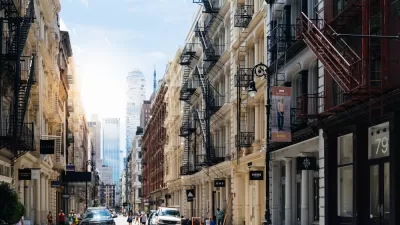A closely watched rezoning effort in New York City cleared a key City Council committee last week, while making some concessions from the original vision to get across the finish line.

Kathryn Brenzel reports for TheRealDeal that the New York City Council has reached a compromise to get Envision SoHo/NoHo one critical step closer to full approval, dialing back some of the density in the vision for this relatively wealthy corner of Manhattan.
The version of the plan approved by the City Council's Committee on Land Use last week "reduces the commercial floor-area ratio in most of the rezoning area to 5 from the original proposal, in which FAR was 10 in three areas," reports Brenzel. "In the Bowery corridor in Noho, the commercial FAR is 7 and the residential FAR is 12, as recommended by City Planning."
"Despite the last-minute changes, the plan as a whole will dramatically increase the amount of development allowed in the high-income, relatively low-scale neighborhoods. It is a victory for the administration and advocates for affordable housing, not to mention the real estate industry," writes Brenzel.
Planners in New York City began working on the controversial rezoning plan in 2018, and the narrative about the rezoning process quickly turned to relative wealth of the neighborhoods included in the plan compared to other parts of the city rezoned during the de Blasio administration (advocates are pushing the city to for rezone for more residential density in other affluent parts of the city in the wake of Envision SoHo/NoHo).
More details on the final plan are available in the source article linked below. An earlier article by Brenzel, published two days earlier, detailed the political maneuvers that preceded to the compromise.
FULL STORY: City Council tweaks Soho rezoning, assuring its passage

Study: Maui’s Plan to Convert Vacation Rentals to Long-Term Housing Could Cause Nearly $1 Billion Economic Loss
The plan would reduce visitor accommodation by 25,% resulting in 1,900 jobs lost.

Placekeeping: Setting a New Precedent for City Planners
How a preservation-based approach to redevelopment and urban design can prevent displacement and honor legacy communities.

Using Old Oil and Gas Wells for Green Energy Storage
Penn State researchers have found that repurposing abandoned oil and gas wells for geothermal-assisted compressed-air energy storage can boost efficiency, reduce environmental risks, and support clean energy and job transitions.

Washington State Plans Ambitious ‘Cycle Highway’ Network
The state is directing funding to close gaps in its existing bike network and make long-distance trips more accessible.

Homeowners Blame PG&E for Delays in ADU Permits
The utility says it has dramatically reduced its backlog, but applicants say they still face months-long delays for approvals for new electrical work.

Rethinking Wildfire Defense: How a Landscape Approach Can Protect Neighborhoods
Post-fire analysis of the Eaton Fire reveals that a landscape approach — including fire-resistant vegetation, home hardening, and strategic planning — can help reduce wildfire risk, challenging assumptions that trees and plants are primary fire hazards.
Urban Design for Planners 1: Software Tools
This six-course series explores essential urban design concepts using open source software and equips planners with the tools they need to participate fully in the urban design process.
Planning for Universal Design
Learn the tools for implementing Universal Design in planning regulations.
Borough of Carlisle
Caltrans
Heyer Gruel & Associates PA
Institute for Housing and Urban Development Studies (IHS)
City of Grandview
Harvard GSD Executive Education
Salt Lake City
NYU Wagner Graduate School of Public Service
City of Cambridge, Maryland





























